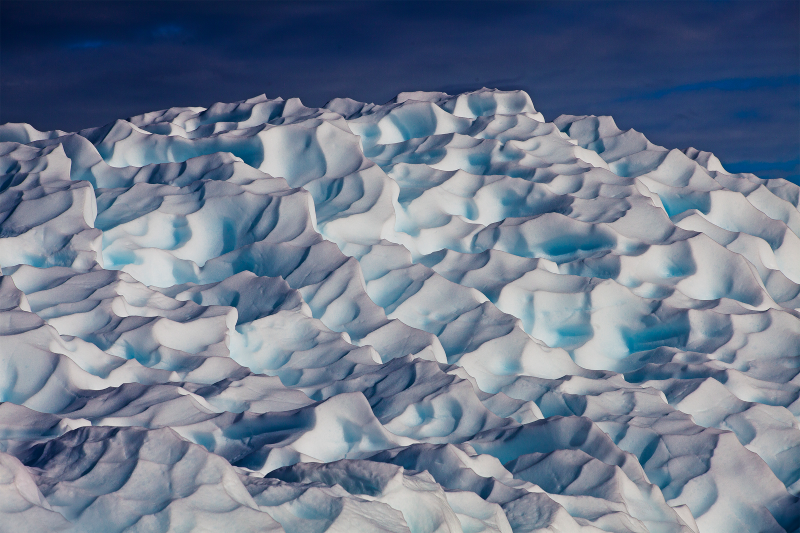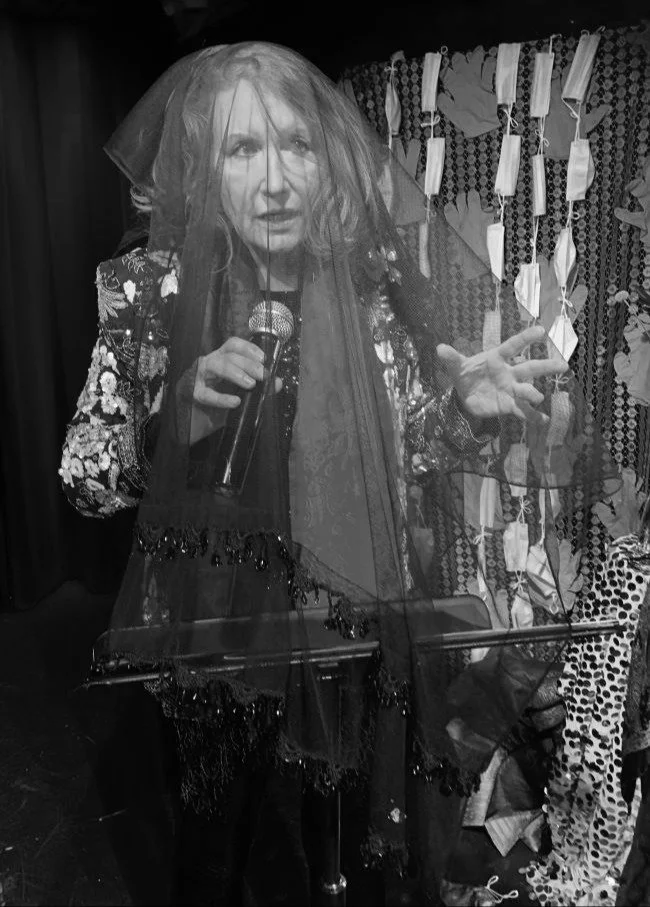PATRICIA CARR MORGAN'S explorations of memory, loss, & reality
Photo by Stephen Yeakley
Patricia Carr Morgan is a conceptual artist based in Tucson, Arizona who has shown her work in museums and galleries across the U.S. and in China, and has enriched communities with her public art. Morgan explores memory, loss, and reality through sculpture, interdisciplinary installation, and photography. It is this last medium that drives her new work, an exploration of glacier ice and climate change.
Interview by Isabel Hou
Your artistic journey has transitioned from various forms, including sculpture and photography. How do these different mediums complement and challenge your creative process?
The different mediums I've used throughout my work are the result of the creative process. Moving to Los Angeles and seeing the La Brea Tar Pits, for instance, caused me to think of asphalt and how beautiful and gloppy it can be. Black is an excellent color and can prompt many associations. Smeared on the back of the glass, it highlights the green iron oxide, creating a beautiful sheen and subtle reflections. It's a good material for a barren cube like Priapic Cube.
Using baby bottle nipples was a given when commenting on nurturing in The Eternal Supper. Blue neon beneath the floor and continuing up the sides of a smoked Plexiglas trapezoid creates an otherworldly sense of suspension in the contemporary tomb Enclosure XVIII. After much experimenting, silk organza was the best material for the glacier photographs in Blue Tears for its strong yet fragile nature. I use whatever medium and materials are appropriate for the concept.
In your series I love you don’t leave me, you explore the themes of loss and environmental decay. Can you discuss how personal experiences have influenced your approach to these themes?
Traveling to Alaska over the years, I've seen the Mendenhall Glacier recede, and my concern has been amplified as scientists learn more. My first trip to Antarctica was reluctant, but I quickly fell in love with the endless white expanse and the vibrant blues in the ice. It was like nothing I had seen before and I wanted more. I went to Greenland and back to Antarctica to photograph. The polar regions were no longer a stranger to me, and I developed a deep feeling for the icescape.
None of us have escaped loss, and many know it well. I hope the audience will see and feel a kinship to the beauty of the glaciers, mourn their loss, and be prompted to take action.
The use of expired film and coal in your work adds a unique texture and narrative. How did you arrive at these materials, and what do they symbolize in your art?
After Blue Tears, I wanted to talk about the degradation of the glaciers. Everyone knows coal and carbon are villains, and coal adds texture and brutal beauty to the photograph. The carbon, mixed with acrylic medium, is used as paint and glue. The passage of time is a marker of loss, so expired film was a logical choice. I re-photograph the original with expired film, and its degradation creates a new image. Different brands give different results, and depending on the amount of damage and abuse, the film results are unpredictable. The prints reflect the uncertainty of future outcomes.
Your work often blurs the line between realism and abstraction. What drives you to navigate between these two realms, and how do you find balance
We see the present, but tomorrow is an abstraction created from today's reality. Liquescence is the series of my original images re-photographed with expired film. I print these so they appear to be melting or disintegrating, but while some have enough detail to recognize the glacier, others are very abstract. The line is blurred, but the abstraction is an unknown future.
Works from Liquescence
In your installations, such as Blue Tears, you create immersive experiences for viewers. What do you hope people take away emotionally and intellectually from these installations?
While I always start with a concept, and the work reflects this emotionally, I hope the viewer brings their own experience and finds both provocative.
What the viewer sees, and their spatial relation to the work is essential to me and usually relates to the concept. In Village One, the viewer interacts by walking into a large house frame. Then, moving from one shaft house to another, they learn different ways to see into houses where I've placed objects. The smaller houses represent both a village and a single psyche. The interaction creates more connections and opens more avenues for meaning.
Blue Tears compels the viewer to walk around it, look up at the glacier images, and follow the organza veil down to the fallen veils that make an undulating sea below. A clock ticks, and the installation towers over them like the glaciers and icebergs, some veils falling to the floor like a calving glacier. Some people told me they cried as pieces fell to the ground during the performance at the Tucson Museum of Art. Docents reported that some school children had never heard of global warming before seeing Blue Tears.
For me, my work is a conversation of thought and feeling. I hope that my work will prompt the viewer to delve into their own emotions and background to create meaning and enhance the place I gave them to start.
Images from Blue Tears, courtesy Tucson Museum of Art
As someone who has witnessed drastic environmental changes, what role do you believe artists play in raising awareness about climate change?
Artists are one of many voices, and everyone and all venues are important. Every audience will vary, so the message should be everywhere, by everyone.
How has your perception of nature and its fragility evolved through the process of documenting glaciers in Antarctica and Greenland?
When photographing in Antarctica for the first time, I felt like I was getting to know a new friend, and that connection has remained strong. I have talked about my early experience in Yosemite, sitting alone at night at the base of half dome, knowing that ancient glaciers had carved the spot I sat in and that I was a tiny speck in history. To be part of something so vast and enduring was comforting. Now, because of our actions, my pleasure is not so calm. It's disrupted by anxiety and worry that the next generations won't understand what has been lost.
Photographs from Ice: Greenland & Antarctica
Your art makes a poignant statement about climate change. How do you maintain hope and channel it into your work amid the challenging realities of environmental degradation?
Action comes from the hope for change. Information from the Webb telescope tells us Earth is a rarity and should be cared for, but despite our knowledge we're not putting this issue at the top of all lists. An interesting and hopeful book is Climate Chaos: Lessons on Survival From Our Ancestors, by archaeologists Brian Fagan and Nadia Durrani, about our need to work locally and learn from the conservation tactics used by our ancient ancestors.
You've mentioned that your art has been influenced by film, nostalgia, and mythology. Can you elaborate on how these elements interplay in your current projects?
Reality is a Good Likeness was about film and reality. My current work doesn't have such a strong connection, but I still like movies and see as many as possible. The Zone of Interest, directed by Jonathan Glazer, is the most recent and it is a masterpiece by extraordinary people. It quietly shows us a bifurcated mind and the evil it facilitates. It reminds me that our bifurcated minds allow us to push what we know aside and neglect our planet.
Isabel Hou is a rising senior at Cornell University interested in art, writing, and law. She plans to live and work in Manhattan post-grad. When she’s not in New York, she’s based out of Colorado, where she enjoys the mountains, the art, and the solitude.















